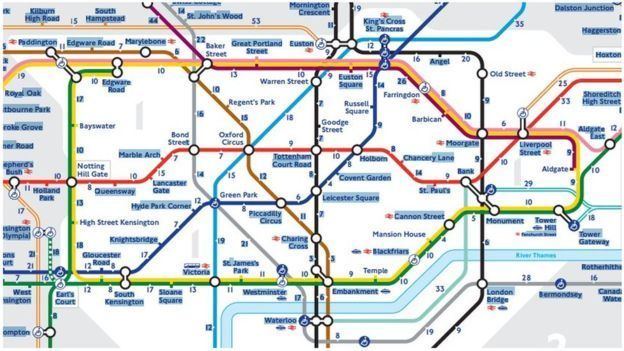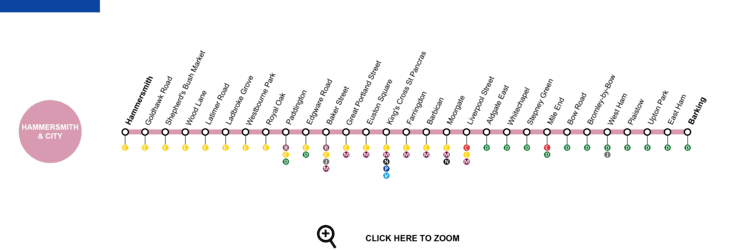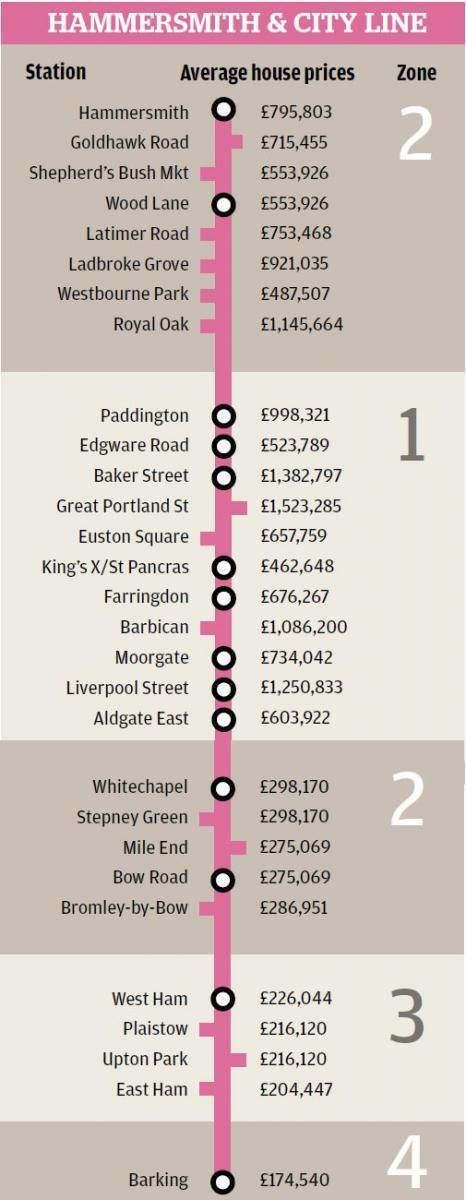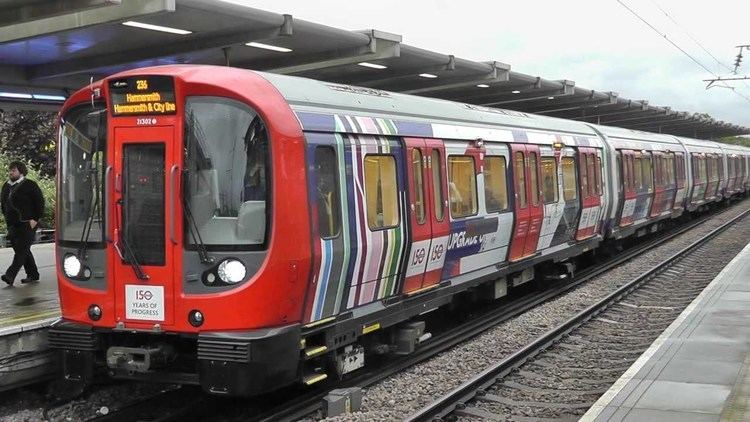Type Sub-surface Colour on map Salmon pink Stations 29 | Website tfl.gov.uk | |
 | ||
Ridership 114.6 million (2011/12) passenger journeys Opened Infrastructure opened in stages between 1863 and 1902, shown as a separate line on the tube map from 1990. | ||
The Hammersmith & City line of the London Underground runs between Hammersmith and Barking. Coloured salmon pink on the tube map, it serves 29 stations in 15.8 miles (25.5 km). It runs below ground in the central section between Paddington and Bow Road; between Farringdon and Aldgate East it skirts the City of London, the capital's financial heart. The tunnels are just below the surface and are a similar size to those on British main lines. Most of the track and all stations are shared with the District, Circle or Metropolitan lines, the other parts of London Underground's sub-surface railway, and over 114 million passenger journeys are made each year on this line and the Circle line.
Contents
- Metropolitan Railway
- London Transport
- A separate identity
- Route
- Services
- Rolling stock
- Depot
- Upgrade programme
- References

In 1863, the Metropolitan Railway began the world's first underground railway service between Paddington and Farringdon with wooden carriages and steam locomotives. The following year, a railway west from Paddington to Hammersmith was opened and this soon became operated and owned jointly by the Metropolitan and Great Western railways. The line was then extended to the east, in stages, reaching the East London Railway in 1884. The line was electrified in 1906, and, in 1936, after the Metropolitan Railway had been absorbed by London Passenger Transport Board, some Hammersmith & City trains were extended over the former District Railway line to Barking. The Hammersmith & City route was shown on the tube map as part of the Metropolitan line until 1990, since when it has appeared as a separate line.

The track and signalling systems are being upgraded, and the old 6-car C Stock trains have been replaced by new 7-car S Stock trains in a programme to increase capacity by 65 per cent by 2019.

The line runs parallel to the Great Western Main Line between Paddington and Westbourne Park, and parallel to the London, Tilbury and Southend Railway between West Ham and Barking.
Metropolitan Railway

The first line built by the Metropolitan Railway (Met) was from Paddington to near Smithfield, near London's financial heart in the City; with gas-lit wooden carriages hauled by steam locomotives opened on 10 January 1863 it was the world's first underground railway. The line was built mostly under the New Road using the "cut-and-cover" method between Paddington and King's Cross and then in tunnel and cuttings beside Farringdon Road. Supported by the Met and the Great Western Railway (GWR), the Hammersmith & City Railway (H&CR) was built from the GWR's main line a mile west of Paddington station to the developing suburbs of Shepherd's Bush and Hammersmith. Built on viaduct largely across open fields, the line opened on 13 June 1864 with a GWR service from Farringdon to Hammersmith, services to Addison Road (now Kensington (Olympia)) on the West London Railway via a link at Latimer Road starting a few weeks later. From 1865 the Met ran trains to Hammersmith and the GWR trains to Addison Road. In 1867 the line became jointly owned by the two companies. In 1871 two additional tracks parallel to the GWR between Westbourne Park and Paddington were brought into use for the H&CR, and in 1878 the flat crossing at Westbourne Park was replaced by a dive-under. A year earlier some services had been extended via London & South Western Railway's Hammersmith (Grove Road) railway station and their line to Richmond.

The railway was extended east of Farringdon and a terminus opened at Aldgate on 18 November 1876. The Met wished to access the South Eastern Railway via the East London Railway (ELR) and jointly with the District Railway built lines from their Mansion House station to the Met's Aldgate station and east from Aldgate to reach the ELR at Whitechapel. In October 1884 the Met extended some Hammersmith services over the ELR to New Cross.

In 1902 the Whitechapel & Bow Railway was opened, linking the District Railway at Whitechapel to the London, Tilbury and Southend Railway (LT&SR) at an above-ground junction at Bow, to the west of Bromley-by-Bow station, and some District services were extended from Whitechapel to East Ham. When the line was electrified in 1906 services to Richmond were withdrawn and the western termini became Hammersmith and Kensington (Addison Road), and to the east services were diverted from the ELR to Whitechapel, until the ELR was electrified in 1914 and services ran from Hammersmith to New Cross (SER) and New Cross (LB&SCR). The 6-car electric multiple units were jointly owned by the Met and GWR until 1923 when the GWR sold theirs to the Met.
London Transport

On 1 July 1933 the Metropolitan Railway was amalgamated with other Underground railways, tramway companies and bus operators to form the London Passenger Transport Board. To relieve congestion on the District line east of Whitechapel from 1936 some trains from Hammersmith were diverted from the East London line to Barking. Through trains to New Cross and New Cross Gate were withdrawn in November 1939, the Hammersmith & City line trains terminating at Whitechapel while the longer 8-car Uxbridge line trains ran to Barking. However, this caused operational problems and from 1941 Barking was again served by trains from Hammersmith.

From 1937 new steel O stock trains, with doors remotely operated by the guard, replaced the wooden-bodied trains dating from 1906. It had been intended to operate the new trains with four or six cars, but after initial problems with the traction current only six-car formations were used. Services to Kensington (Olympia) via the curve at Latimer Road were suspended in 1940 after bomb damage to the West London line and not restarted after the war. When the similar trains running on the Circle line were lengthened to six cars in 1959 and 1960, the stock of the two lines was integrated with maintenance at Hammersmith depot. Aluminium C Stock trains, with public address systems and originally unpainted, replaced these trains from 1970. One person operation was proposed in 1972, but due to conflict with the trade unions was not introduced until 1984.
A separate identity

The route between Hammersmith and Barking was shown on the tube map as part of the Metropolitan line, but since 1990 has been shown separately, the Metropolitan line becoming the route from Aldgate to Baker Street and northwards through "Metro-Land" to Uxbridge, Watford and Amersham. In 2003, the infrastructure of the Hammersmith & City line was partly privatised in a public–private partnership, managed by the Metronet consortium. Metronet went into administration in 2007 and the local government body Transport for London took over responsibilities. The reconstruction of Whitechapel station for the new Crossrail underground line required the reversing platforms to be taken out of use and since December 2009 all services have been extended to Plaistow or Barking.
The C Stock trains have recently been replaced by S7 Stock; the first new train entered service on the Hammersmith & City line on 6 July 2012, running a shuttle service between Hammersmith and Moorgate before operating between Hammersmith and Barking on 9 December 2012. By March 2014 all services were provided by S7 Stock trains.
Route
The line is 15.8 miles (25.5 km) long with 29 stations. Almost all of its track is shared with the other London Underground sub-surface lines: from Hammersmith to Baker Street with the Circle line, from Baker Street to Aldgate with the Circle and Metropolitan lines, and from Aldgate East station to Barking with the District line. All its stations are shared with other lines.
The line is electrified with a four-rail DC system: a central conductor rail is energised at −210 V and a rail outside the running rails at +420 V, giving a potential difference of 630 V. Much of the 2-mile-35-chain (3.9 km) double-track railway from the Hammersmith terminus to Westbourne Park station is on a 20-foot (6.1 m) high brick viaduct. After Westbourne Park the line passes beneath the Great Western main line re-surfacing at Royal Oak station and running alongside the main lines to Paddington station. The line enters a cut-and-cover tunnel at the end of the platforms and meets the Circle line from Bayswater at Praed Street Junction before passing through Edgware Road station in a cutting. After King's Cross St Pancras the line is in cutting, passing under the Ray Street Gridiron that carries the City Widened Lines used for Thameslink services. There are bay platforms at Moorgate. Just before Aldgate the line diverges from the Circle and Metropolitan lines to Aldgate East. The line passes over the London Overground at Whitechapel station continuing on the 2-mile (3.2 km) former Whitechapel & Bow Railway to Bow Road where it surfaces, and then to Bromley-by-Bow, where it runs alongside the London, Tilbury and Southend line from Fenchurch Street. At the next station, West Ham, there is interchange with the Jubilee line, the Docklands Light Railway and c2c. There is a bay platform at the next station, Plaistow, and the line terminates after two more stations at Barking.
Services
As of December 2012 off-peak there are six trains per hour, calling at all stations, and requiring 15 trains for the peak-hour service. Together with the Circle line, over 114 million passenger journeys are made each year. The journey from Hammersmith to Barking takes 61 minutes off-peak. The central section from Paddington to Aldgate East is in Fare Zone 1, to the west to Hammersmith and east to Bromley-by-Bow in Zone 2. Barking and East Ham are in Zone 4.
Rolling stock
Services are provided by seven-car S Stock, part of Bombardier's Movia family, with air-conditioning as the sub-surface tunnels (unlike those on the deep-level tube lines) are able to disperse the exhausted hot air. These trains have regenerative brakes, returning around 20 per cent of their energy to the network. With a top speed of 62 mph (100 km/h), a 7-car S Stock train has a capacity of 865 passengers, compared to 739 for the six-car C Stock train it replaced. With a length of 384 feet (117 m), S Stock trains are 79 feet (24 m) longer than 305-foot (93 m) long C Stock trains and station platforms have been lengthened. It is planned to increase the traction voltage from the present nominal 630 V to 750 V to give better performance and allow the trains to return more energy to the network through their regenerative brakes.
Depot
The line's depot is at Hammersmith, close to Hammersmith station, built by the Great Western Railway to be operated by the Metropolitan Railway when the joint railway was electrified in the early 20th century. Sidings at Barking and near High Street Kensington (Triangle Sidings) stable trains overnight. Sidings at Farringdon were used during the C stock era; due to the greater length of the new S stock trains, these are no longer in use.
Upgrade programme
Together with the introduction of S Stock trains, the track, electrical supply and signalling systems are being upgraded in a programme planned to increase peak-hour capacity on the Circle and Hammersmith & City lines by 65 per cent by the end of 2018. A single control room for the sub-surface railway is to be established in Hammersmith and an automatic train control (ATC) system will replace signalling equipment installed from the 1940s. The cross-London Crossrail line, planned to open in 2018, is expected to reduce crowding between Paddington and Whitechapel.
